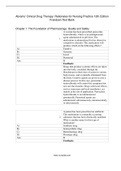Exam (elaborations)
Test Bank For Abrams’ Clinical Drug Therapy Rationales for Nursing Practice 12th Edition Geralyn Frandsen 12th Dec 2022
A woman has been prescribed paroxetine hydrochloride, which is an antidepressant agent administered in pill form. The medication is administered for her obsessive compulsive disorder. This medication will produce which of the following effects?
[Show more]



